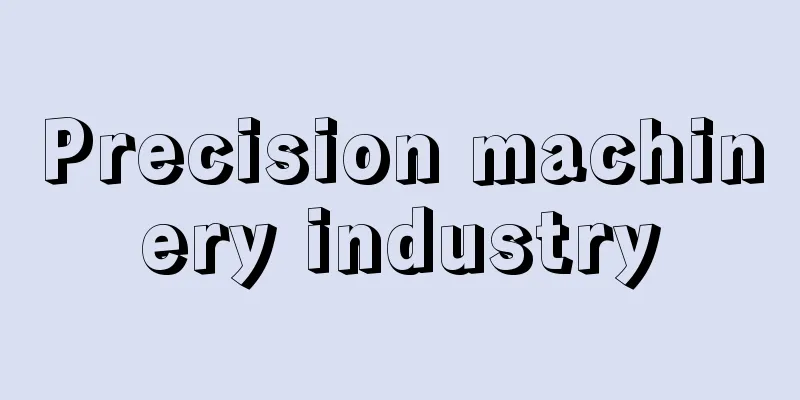Precision machinery industry

|
This is an industry that produces instruments that require high precision, such as measuring instruments, optical instruments, electronic devices, medical devices, glasses, and watches. In the Japan Standard Industrial Classification, the eyeglasses manufacturing industry and the watches and related parts manufacturing industry are classified as "other manufacturing industries," and other related manufacturing industries are classified as "commercial machinery and equipment manufacturing industries." (Before the 2007 revision, the following industries were classified under the heading of "precision machinery and equipment manufacturing industry," but they were reorganized to accommodate changes in the production structure of machinery and equipment.) In addition, in the Tokyo Stock Exchange's 33-industry classification, watches, electronic devices, optical devices, measuring devices, communication devices, small machine tools, etc., and medical instruments such as catheters, artificial organs, and dental materials and equipment are classified as precision instruments. Therefore, the precision machinery industry is usually composed of the manufacturing industries of measuring instruments, medical equipment, scientific equipment, optical equipment, lenses, glasses, watches, and small machine tools. The precision machinery industry encompasses a wide variety of industries, and with the advancement of digitalization, it is promoting the fusion of similar businesses between different manufacturing industries or within the same company. All of these fused fields are centered on the production of machinery and equipment that requires a high level of precision. The technological level of Japan's precision machinery industry is high, and it is notable for its strong international competitiveness. Furthermore, development in cutting-edge fields such as micromachines and nanomachines is also progressing. [Katsuaki Onishi May 19, 2016] Development processJapan's precision machinery industry has a long history, with a perpetual clock being produced in 1851 (Kaei 4) by Tanaka Hisashige, founder of Tanaka Manufacturing (later Shibaura Manufacturing, now Toshiba). Later, in 1873 (Meiji 6), Konishiya Rokubeiten (later Konishiroku Honten, Konica, now Konica Minolta), which handled photography and lithography materials, was established. Meanwhile, in 1914 (Taisho 3), a Japanese-language typewriter was produced, and in 1916 Nippon Seiko was established. However, Japan's precision machinery industry before World War II was not in a position to compete internationally. The policy of prioritizing military production before and during the war hindered the development of civilian machinery. Clock and office machine factories were forced to convert into military factories, and production was halted with some exceptions, and the factories were also damaged by the war. However, unlike other sectors, optical equipment was given more importance because it had military applications and independent development was an issue due to the cessation of imports from Europe during World War II. The pioneering role that camera production played after the Second World War was based on the footsteps of the optical equipment field. Camera production increased productivity, boosted exports, and contributed greatly to Japan's acquisition of foreign currency during the recovery period. It was during the period of high economic growth that the precision machinery industry made a groundbreaking leap forward. Driven by the growing demand for watches, high-performance automatic processing machines and high-precision measuring instruments were introduced, and watch production using assembly lines equipped with conveyer belts became established. In the case of cameras, a mass production system was established, and the production of 35mm cameras increased rapidly. The transformation of production processes and mass production accompanied by the development of new products like these are not limited to watches and cameras, but also extend to office machines and other fields. Furthermore, the development of heavy chemical industries and increased capital investment promoted the instrumentation of machines and equipment, expanding the market for measuring instruments. After the oil crisis of 1973, the international competitiveness of the precision machinery industry was further strengthened, even though some areas suffered from overproduction. With the development of electronics technology, precision machinery became more sophisticated, and the progress of medical equipment and semiconductor manufacturing equipment was particularly remarkable. Digital cameras, clocks with power generation functions, and radio-controlled clocks were developed. Furthermore, in the field of measuring instruments, electrical measuring instruments such as semiconductor and IC measuring instruments emerged, and in the field of copying machines, there was a noticeable shift from analog machines to digital machines, color machines, and multi-function machines. Canon and Ricoh held more than 40% of the world market share, and Canon and Seiko Epson also led the world in printers. In the digital camera sector, precision machinery manufacturers such as Canon, Olympus, Fuji (photo)film, Nikon, Casio Computer, and Asahi Optical (Pentax) almost monopolized the global market. Japan's precision machinery industry built strong international competitiveness and expanded exports. [Katsuaki Onishi May 19, 2016] Trends since the 1990sAfter the collapse of the bubble economy, the precision machinery industry, especially after 1996, suffered a long-term decline in performance. From 1990 to 2000, production scale was halved, the number of business establishments decreased by more than 2,000, and the number of employees decreased by nearly 100,000 (Industry Statistics Table: Statistics on Business Establishments with 4 or More Employees). Some exports increased, but the majority of exports were semiconductor manufacturing equipment, copiers, and medical equipment, not watches or cameras. The export and import values of watches and cameras have reversed, and a system of import dependence has been formed. The situation remains difficult even in the 21st century, with the birth of Konica Minolta Holdings in 2003 (renamed Konica Minolta in 2013), and Pentax being absorbed into HOYA in 2006 (later becoming Pentax Ricoh Imaging under Ricoh's umbrella in 2011, and then Ricoh Imaging in 2013). However, in 2013, the number of establishments in the measuring, analytical, testing, surveying, and physico-chemical machinery and equipment manufacturing industry was 1,516, with 55,278 employees and a shipment value of 1,447.5 billion yen, a decrease in the number of establishments compared to 2010, but a slight increase in the number of employees and shipment value. The increase was driven by scales, precision measuring instruments, and testing equipment, particularly the physico-chemical machinery and equipment manufacturing industry. The number of establishments in the medical equipment and supplies manufacturing industry was also down from 2010, with 1,090 establishments and 45,214 employees in 2013, with only the shipment value increasing to approximately 1,119.9 billion yen. In 2013, the number of establishments in the optical machinery and lens manufacturing industry was 523, with 22,972 employees and a shipment value of approximately 4,894.8 billion yen, with all indicators showing a downward trend. The number of watch and watch parts manufacturing establishments in the same year was 91, with 7,441 employees and a shipment value of approximately 239.1 billion yen, while the shipment value of eyeglass manufacturing was 108.8 billion yen, with 253 establishments and 7,928 employees, both of which are down from 2010 (Industry Statistics Table: Statistics on establishments with 4 or more employees). Scientific and optical instruments are also a major export item from Japan, and although they fell during the Lehman Shock in 2008, they rose to approximately 2,261 billion yen in 2015. The weight of export destinations in Asia was high, at 1,583.9 billion yen, accounting for 70%, and in particular, exports to China, although declining, accounted for 37.6% at 850.2 billion yen. The import value of precision machinery has been increasing, and comparing export and import values, import values were less than 30% of export values in 1990, but exceeded 40% in 2000. And the import value of scientific and optical instruments in 2015 reached 73% of export values. Imports from Asia are the largest, but there is not much difference between the United States, the European Union (EU), and China (Ministry of Finance, Trade Statistics). Also, the amount of foreign direct investment in the flow of precision machinery in 2014 fell to 644 million dollars and is on a downward trend (JETRO, World Trade and Investment Report). [Katsuaki Onishi May 19, 2016] [Reference items] | | | | | | |Source: Shogakukan Encyclopedia Nipponica About Encyclopedia Nipponica Information | Legend |
|
測定機器、光学機器、電子機器、医療用機器、眼鏡、時計など、高い精度が要求される機器を生産する工業。日本標準産業分類においては、眼鏡製造業、時計・同部分品製造業は「その他の製造業」に、他の関連製造業は「業務用機械器具製造業」に分類されている(2007年の改定以前は「精密機械器具製造業」という項目の下に、計量器・測定器・分析機器・試験機製造業、測量機械器具製造業、医療用機械器具・医療用品製造業、理化学機械器具製造業、光学機械器具・レンズ製造業、眼鏡製造業、時計・同部分品製造業が分類されていたが、機械器具の生産構造の変化に適合させるため再編された)。また、東京証券取引所の33業種分類では、時計、電子機器、光学機器、計測機器、通信機、小型工作機械等とカテーテル・人工臓器・歯科用材料器具等医療用器具を精密機器としている。それゆえ、通常、精密機械工業は、計測機器・医療用機器・理化学機器・光学機器・レンズ・眼鏡・時計製造業、小型工作機械製造業等から構成される。多様な業種を包摂している精密機械工業は、デジタル化の進展により、各製造業間ないしは同一企業内で類似する事業の融合化を進めている。融合化されたどの分野も、高水準の精度を要求される機械器具の生産を主体としている。そして、日本の精密機械工業の技術水準は高く、強力な国際競争力を有している点で注目される。さらに、マイクロマシン、ナノマシンといった先端領域の開発も進展しつつある。 [大西勝明 2016年5月19日] 展開過程日本の精密機械工業の生成は古く、1851年(嘉永4)には田中製造所(のちの芝浦製作所。現、東芝)の創業者田中久重(ひさしげ)により万年時計が製作されている。その後、1873年(明治6)には写真および石版材料を取り扱う小西屋六兵衛店(のちの小西六本店、コニカ。現、コニカミノルタ)が創業した。他方、1914年(大正3)には和文タイプライターがつくられており、1916年には日本精工が設立されている。しかし、第二次世界大戦前の日本の精密機械工業は、国際競争を展開できるような状態にはなかった。戦前、戦中の軍事生産優先政策が、民需機器の発展を阻んできた。時計、事務機械の工場は軍事工場への転換を強制され、一部を除き生産が中断され、そのうえ工場は戦禍を受けることになる。ただ、光学機器のみは、軍事的用途をもち、かつ第二次世界大戦中ヨーロッパからの輸入の途絶により自主開発が課題となっていたことから、他部門とは異なり重要視された。 第二次世界大戦後のカメラの生産が果たした先導的役割は、こうした光学機器分野の足跡を基盤としている。そして、カメラ生産は、生産性を高め、輸出額を伸ばし、復興期の日本の外貨獲得に大きく貢献した。その後、精密機械工業が画期的な躍進を遂げるのは高度成長期である。時計需要の増大に牽引(けんいん)され、高性能な自動加工機や、高精度の測定器の導入が進み、ベルトコンベヤーを装備した流れ作業による時計生産が定着した。カメラの場合も、マスプロ(量産)体制を確立して35ミリカメラの生産が急増している。こうした新製品開発を伴った生産工程の変革、量産化は、時計、カメラにとどまらず、事務機械や他の領域にも及んでいる。また、重化学工業化、設備投資の増大は、機械・装置の計装化を推進することになり、計測機器市場が拡大している。 1973年(昭和48)のオイル・ショック後、一部で生産過剰をきたしながらも、精密機械工業の国際競争力はいっそう強化されることになる。エレクトロニクス技術の発展により、精密機械が高性能化しており、とくに、医療用機器、半導体製造装置の躍進は目覚ましかった。そして、デジタルカメラや発電機能つき時計、電波時計が開発された。さらに、計測機器分野では半導体・IC測定器など電気計測器が台頭し、複写機分野ではアナログ機からデジタル機、カラー機、複合機へのシフトが顕著なものとなる。キヤノン、リコーが世界のマーケットシェアの40%以上を占め、プリンターでもキヤノン、セイコーエプソンが世界をリードしていた。デジタルカメラ部門でも、キヤノン、オリンパス、富士(写真)フイルム、ニコン、カシオ計算機、旭光学(ペンタックス)等の精密機械メーカーが世界市場をほぼ独占していた。日本の精密機械工業は強力な国際競争力を構築し、輸出をも拡大した。 [大西勝明 2016年5月19日] 1990年代以降の動向バブル経済の崩壊後、精密機械工業は、とくに、1996年(平成8)以降業績悪化を招き、長期的な低落傾向に陥ることになる。1990年から2000年(平成12)にかけて生産規模は半減し、事業所数は2000以上も減り、従業者も10万人近く減少している(『工業統計表』従業者4人以上の事業所統計)。一部輸出が増大しているが、輸出の過半を時計やカメラではなく半導体製造装置、複写機、医療用機器が占めた。時計やカメラの輸出入額は逆転しており、輸入依存体制が形成された。21世紀に入っても状況は厳しく、2003年にはコニカミノルタホールディングスの誕生があり(2013年コニカミノルタに名称変更)、2006年にはペンタックスがHOYA(ホーヤ)に吸収合併されている(その後2011年リコー傘下のペンタックスリコーイメージングとなり、2013年リコーイメージングに名称変更)。ただ、計量器・測定器・分析機器・試験機・測量機械器具・理化学機械器具製造業の2013年の事業所数は1516、従業者数5万5278人、出荷額は1兆4475億円であり、2010年比で事業所数は減少したが、従業者数、出荷額は若干増えている。なかでも、はかり、精密測定器、試験機、とくに、理化学機械器具製造業が増加部分を支えている。医療用機械器具・医療用品製造業も2013年には、事業所数1090、従業者数4万5214人で2010年比で減少し、出荷額のみ約1兆1199億円で増加している。光学機械器具・レンズ製造業の2013年の事業所数は523、従業者数2万2972人、出荷額約4兆8948億円となり、どの指標も減少傾向にある。時計・同部品製造業の同年の事業所数は91、従業者数7441人、出荷額約2391億円、眼鏡製造業の同年の出荷額は1088億円、事業所数253、従業者7928人でいずれも2010年より減少している(『工業統計表』従業者4人以上の事業所統計)。また、科学光学機器は日本の主要輸出品目であり、2008年のリーマン・ショックの際には落ち込んだが、2015年には約2兆2610億円になっている。輸出先はアジアのウェイトが、1兆5839億円で70%と高く、とくに、中国向けは減少しながらも8502億円で37.6%を占めている。精密機械の輸入額は増えてきており、輸出額と輸入額を比べると、1990年には輸入額は輸出額の3割にも満たなかったが、2000年には4割を上回った。そして、2015年の科学光学機器の輸入額は輸出額の73%に達している。アジアからの輸入額が最多であるが、アメリカ、ヨーロッパ連合(EU)、中国とそれほど大きな差はない(財務省『貿易統計』)。また、2014年の精密機械のフローの対外直接投資額は、6億4400万ドルまで低落し、減少傾向をたどっている(ジェトロ『世界貿易投資報告』)。 [大西勝明 2016年5月19日] [参照項目] | | | | | | |出典 小学館 日本大百科全書(ニッポニカ)日本大百科全書(ニッポニカ)について 情報 | 凡例 |
<<: Precision casting - Seimitsuchuzo (English spelling) precision casting
>>: Founding of the Seimi School - Seimikaisou
Recommend
Voronkova, LF (English spelling) VoronkovaLF
...Soviet realistic novels for children were form...
Everett, JD
...This is called the Gregory–Newton formula (or ...
National Finance Corporation
A government financial institution established in...
Shuichi Goto
Born: August 12, 1888 in Kamakura [Died] July 30, ...
Kim Manjung - Kinmanju (English spelling)
[Born] King Injo 15 (1637) [Died] Sukjong 18 (1692...
Türheim, U.von (English spelling) TurheimUvon
…Compared to Wolfram's difficult and dark sty...
Marie de Vichy-Chamrond, Marquise du Deffand
A famous salon host in 18th century France. Encyc...
Cetewayo
...Dingane repelled the Boers, who had advanced i...
Robinson, ESL (English spelling)RobinsonESL
...This work, with its ruthless observations and ...
Anerio, GF (English spelling) AnaerioGF
A cappella is a group of musicians who composed c...
RLF
…In type II, the progression is rapid, leading to...
Melanocorypha
…The most desert skylarks are the Ammomanes , whi...
Cape Notsuke
A sand spit that juts out into the Nemuro Strait ...
Ohi Chozaemon
… Senso Soshitsu, the fourth generation after Rik...
Otsuki Joden
1845-1931 A scholar from the Meiji to early Showa...









